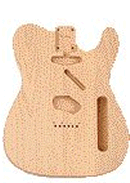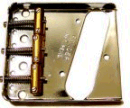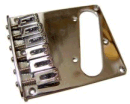|
The Anatomy Of A Telecaster
The Neck
The neck of a Tele is
traditionally bolted onto the body with four or six bolts the heads of which
are covered by a steel blanking plate. If you look around you can find
examples of all neck mounting styles amongst the telecaster copies - bolted,
glued and screwed; set (glued) and even through necks where the neck
continues right through the body and has the bridge mounted directly on it.
This single piece construction can improve the resonance and sustain of the
guitar, but to the Tele purist - "it ain't no Telecaster". A
detachable neck is an essential feature of a Tele. It enables you to change
the neck easily - if the neck is damaged, worn or you simply want to try a
different style.
Leo Fender's first guitar necks were built in like those of a Spanish guitar
with thick 'U' profiles because they had no truss rod to take the string
tension. This quickly changed with the introduction of a metal rod (the truss
rod) through the length of neck to give strength; allow a thinner profile
neck and permit adjustment of the neck tension (see setting up your guitar).
Originally, the fingerboard and neck were cut from a single piece of maple,
so the truss rod was loaded into the neck from the back. The resulting
channel was then back-filled with a rosewood inlay giving the characteristic
skunk stripe on the back of the neck of early Telecasters.
Telecaster necks are generally narrower at the nut (the top end of the
fingerboard, by the headstock) than other styles of guitar, in some cases as
little as 1.61" (41mm). Even vintage Teles, with their deep 'U' section
neck are only 1.65" (42mm) wide at the nut which is the average for most
'standard' Telecasters. Some players have found this a little too narrow for
comfort and modern necks tend to be a little wider at 1.6875" (43mm),
making fretting at the neck a little easier. The narrowness of the neck
certainly contributes to the playing style adopted by most Telecaster
aficionados.
The Fingerboard
The neck and fingerboard of modern Telecasters are usually two distinct
pieces, allowing the truss rod to be loaded into the neck from the front,
before the fingerboard is fitted. This allows the manufacturer to offer
different types of fingerboard while minimising construction costs. Most
Telecasters feature maple or Rosewood fingerboards, although ebony and other
more expensive woods can be found. Maple is generally thought to give a
brighter tone than rosewood, but since so many guitarists grow up using
rosewood fingerboards on other types of guitars, Rosewood is offered on some
Telecasters as a familiar alternative.
The radius of the fingerboard (the curvature from edge to edge) of
Telecasters varies from 7.5" (184m) on vintage models to a gentler
9.5" (241mm) or even 10.5" on later models. In general, the
fingerboard radius is tighter than that found on other styles of guitar,
where the radius is often as great as 12.5". The tighter radius
contributes to the unique nature of the Telecaster.
Fingerboards usually have 21 or 22 frets, constructed with Medium or medium
jumbo fretwire. The neck should meet the body at the 17th fret, access to the
higher frets being via the single cutaway of the body.
The Body
The body of a solid bodied
electric guitar contributes significantly to the resonance and tone of the
instrument. The best Telecasters are cut from a single piece of solid
tonewood, with cavities routed out for the pickups and controls. A tonewood
is a medium to densely grained hardwood, chosen for its resonant qualities.
Telecaster bodies are not usually cut from very dense woods such as mahogany.
When Leo Fender started out, he never specified which wood the bodies were
cut from, using whichever woods were available at the time, although he
principally used Alder and settled on that as the standard. These days Fender
Telecaster bodies are either Alder or Swamp Ash. Good copy guitars use a
variety of woods - Alder, Ash, Poplar, Agathis, Basswood and a host of other
seasonal woods - the cheaper copies may even use plywood or MDF!
How do you tell what the wood is under layers of paint and lacquer without
destroying the finish? The simplest way to judge the quality of the wood in
the body is to feel the weight of the guitar - a good Tele clone will weigh
around 4kgs. If you can remove the pickguard you will expose some unpainted
wood in the body cavity routings for examination. Of course, with a painted
and lacquered guitar body, it is difficult to tell whether the body is cut
from a single piece of wood or a number of glued pieces. With glued pieces
the joins may just be visible as minute ridges in the finish, but skilled
paint and lacquer applications will completely mask this. Ultimately the only
way to tell if it's a good body is to try it! Play the guitar unamplified to
judge its resonant qualities.
Headstock
The headstock on a Telecaster, whilst having no real affect on the sound of the guitar, is one of it's most recognisable characteristics. Lean and mean, with the tuning pegs aligned along it's upper edge, it has a smaller profile than the headstock of other Fender models.
Bridge
The original Telecaster bridge featured three individually adjustable brass saddles with the strings passing through the bridge plate to be secured by metal ferrules mounted in the guitar's body. This arrangement, designed by Leo Fender himself has the benefit of maximising the resonance and sustain of the guitar. The large brass saddles provide a good point of contact with the guitar as they have relatively high mass, the contact being pyrther enhanced by the strings passsing through the body.
The disadvantage of this arrangement is that the intonation of the guitar is a compromise as pairs of strings have to share the same string length. To combat this, the modern six saddle bridge is available as an alternative on many Telecaster variants. The intonation is perfect, at the expense of some of the guitar's resonance.
The toploader bridge appeared during the CBS years at Fender. On a toploader, The strings are secured through the back edge of the bridge plate, rather than passing through the body which helps bring the manufacturing cost of the guitar down as precision drilled holes are not required in the body to secure the strings. Securing the strings on the bridge plate further reduces the strings contact with the body of the guitar and thus reduces the resonance and sustain of the intrument. Toploader bridges are available in both three and six saddle varieties but are generally only used on budget guitars these days.
© COPYRIGHT 2005 ALL RIGHTS
RESERVED WWW.NOCASTER.CO.UK
All marks, indicated or otherwise are acknowledged as the property of their respective owners |

|












Necks

A Naked Body

Squier
Headstock

Vintage Bridge

Modern Bridge
|
![]()
![]()
![]()
![]()




